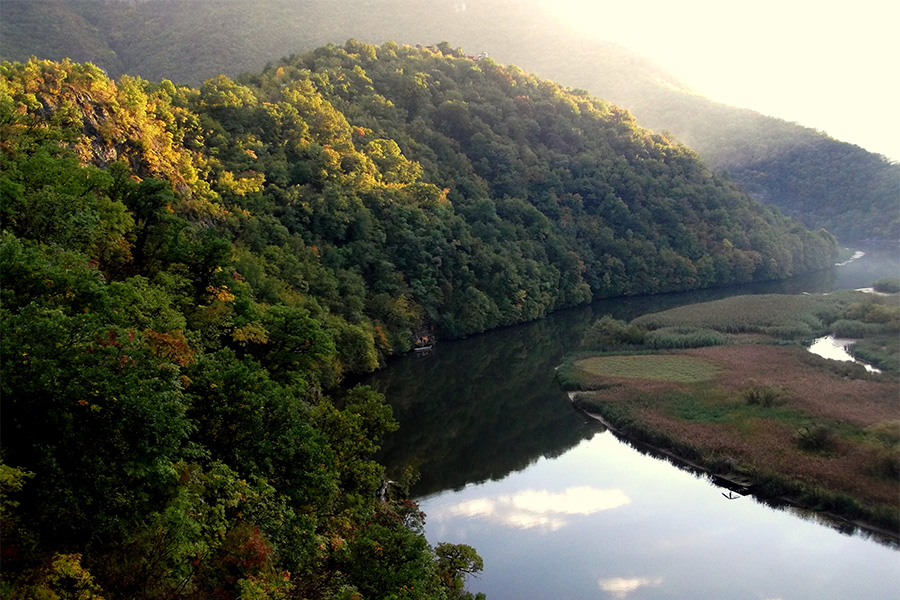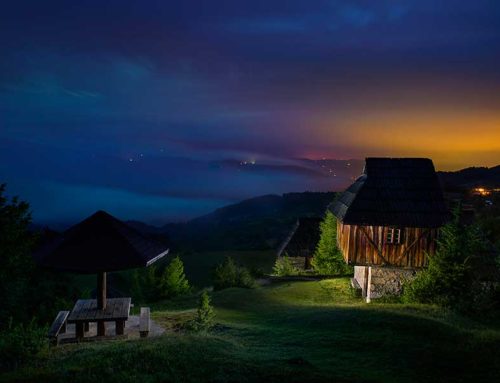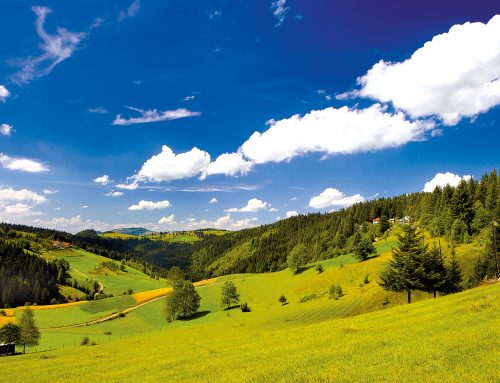TOS recommends: Active rest in Serbia
“Situated where vast plains and afforested mountains meet, Serbia invites you to discover it: from its wild wetland forests along the Danube to the tame lowlands as wide as a sea; from the breathtaking canyons to medicinal spas and springs; from the gentle hills to the wind-whipped summits; from hectic urban centers to the tranquility of remote mountain villages,” wrote Milja and Ivan Vuković, the authors of the TOS publication entitled “Hiking and Cycling”.
Anyone who wishes at one moment to discover Serbia either by hiking or riding a bike will find all the important pieces of information in this well-thought out and precisely arranged guidebook: the difficulty of the trail, the time needed to conquer it, the type of the surface, the altitude differences from the start to the finish, as well as the signs of the features of interest and the gastronomic singularities on the route. We are presenting to you an abbreviated, edited version of this useful publication which inspires people to set on a journey through the beautiful landscapes of our country.
International routes – Eurovelo 6 & 13
Eurovelo 6 connects the Atlantic Ocean and the Black Sea and passes through Serbia following the river course of the Danube. The route goes along the left riverbank of the Danube and first reaches Novi Sad, after which it leads to Belgrade. At the final section of the route, nature and history leave an indelible impression: as you pass through the National Park at the Đerdap Gorge, the largest and the longest gorge in Europe, you may see the valuable cultural heritage – the Neolithic locality of Lepenski Vir (the Lepen Whirl), Trajan’s Tablet, and the mediaeval Fortress of Golubac. The Eurovelo 13 route passes along the imaginary boundary between the former socialist countries and Western countries. Compared with the states “behind the Iron Curtain”, as part of the then Yugoslavia, Serbia had a neutral position. The route starts in the lowlands, only to start climbing the magnificently beautiful mountains, passing through the mountainous landscapes and the Đerdap Gorge. The route connects the multicultural Pannonian North, the cities of Subotica and Kikinda, with the mysterious East of Serbia.
Routes of Đerdap national park
In addition to these international routes, you may “divert” to the expanses of the Đerdap National Park. Its plant life is extremely rich and includes a whole series of relict and protected species. This is also the habitat of large predators: the brown bear, the Balkan lynx, the wolf, the jackal, as well as diverse bird species. There are four recommended routes leading to the belvederes of Ploče, Kovilovo, and Mali Štrbac, as well as the educative trail “Golden Lake”. At the very entrance to Đerdap, there is also Labudovo Okno (The Swan’s Hole) – the largest winter resort for waterbirds in Europe, which is therefore an attractive destination for the lovers of bird spotting.
Belgrade and its surroundings
There are a plethora of historical layers and exciting urban attractions distinguishing Serbia’s capital at the confluence of the Sava and the Danube, at the border dividing the East from the West. Belgrade is also a city of bikers, with its 60 or so kilometers of purposefully designed trails. We single out the two of a large number of possible routes: the one leading through Kosutnjak – the most afforested part of Belgrade, and there is also the nearby mountain of Avala, where you can visit the Monument to the Unknown Hero and the Television Tower, whose belvedere offers a view of all the four directions of Serbia. Aranđelovac town, with its Bukulja Mount, is located in the vicinity of Belgrade. The trail leads from downtown towards the top of the mountain, where there is a vantage point from which gives a panoramic view of the whole region of Sumadija.
Pannonian trails and Fruska gora
Srem, Banat and Backa are the regions that make up Vojvodina. Subotica – a city recognizable for its secessionist architecture – lies in the North. The recommended trail leads through the Subotica Sands, which is also an interesting area for bird-spotting. The small settlement of Slankamen, named after a spring of salty medicinal water, situated itself in Srem, on the riverbank of the Danube. Old Slankamen’s two trails offer a fascinating view of the Danube. In the extreme east of Banat, there are the highest summit of Vojvodina – The Summit of Gudurica. There is a signposted trail leading towards this peak which offers a beautiful view.
The National Park of Fruska Gora Mount, elevated above the Danube, connects the noble tranquility of the nature and the secluded monastic life with the fertility and deliciousness of the wine-growing hills and orchards. The forests are intersected by the soft trails leading to unexpected belvederes. Out of the networked trails of Fruška Gora, we mention the Stražilovo–Grgeteg Monastery trail, the trail connecting the monasteries of Old and New Hopovo, as well as the trails of Vrdnik Banja Spa. In the immediate vicinity of the isolated peacefulness of the National Park, there are the blooming bustling cities of Novi Sad, Sremski Karlovac, and Sremska Mitrovica.
Valjevo mountain range and Rajac
With its undulating terrain and thick forests, the region of Valjevo is interspersed with plum orchards and raspberry farms. The Gradac mountain river meanders through it as a backbone. The hills around Valjevo are home to the monasteries of Pustinja (A Desert), Ćelije (The Cells) and Lelić. The trails leading through River Gradac Gorge, as well as those leading to the peaks of Mt. Divčibare, are recommended. Rajac is a mountain in the close vicinity of the towns of Ljig and Gornji Milanovac. It is known for its spacious meadows like a green sea and for Scything on Mt. Rajac, an international scything competition. It is also interesting to visit the towns of Takovo and Topola in the neighborhood of Rajac as the historical places telling a story of the Karađorđević and Obrenović dynasties, Banja Vrujci Spa, as well as the monasteries of Vraćevšnica and Bogovađa. Out of the signposted trails, the routes Suvobor-Divčibare, Rajac-Mountaineers’ Home and Takovo-Mountaineers’ Home are recommended.
Tara and Mokra gora
The Tara National Park offers a large number of the possibilities of active rest. Over a thousand different plant species, also including the protected Serbian spruce endemic species (discovered by Pančić), grow on this mountain. After trekking through the magnificent forests and visiting the mountain’s belvederes, whose amazing views will engrave indelible memories in your mind, you can descend to the beautiful river Drina or the lake of Perućac. Tara is networked by mountain and mount-biking trails. The routes Kaluđerske Bare-Zborište-Rača Monastery, the trail leading to one of the most beautiful peaks of Mt. Tara – Zborište (The Gathering Place), as well as the other routes leading to Predov Krst (Predo’s Cross)– the heart of the National Park, the attractive belvedere Banjska Stena (The Spa Rock), and many other hidden corners, are recommended.
Mt. Mokra Gora (Wet Mountain), known for its “Šargan Eight” heritage railway, as well as for “Drvengrad” (Timber Town), a tourist resort settlement constructed by a famous film director Emir Kusturica, leans against Mt. Tara. The recommended trail will reveal to you the Šargan Saddle in a completely new light. You will be enchanted by the unreal landscape and belvederes.
Zlatibor and Uvac river
The spacious glades of the gently undulating plateau of Mt. Zlatibor simply beckon you to stroll. This is the place where sea and mountain air meet, and the whole Mt. Zlabitor is an air spa at the same time. The traditional houses of this region are log cabins, and the most beautiful examples of old Zlatibor houses, dairies and granaries have been relocated to a unique open-air museum of “Staro selo” (“The Old Village”) in Sirogojno village. A special recommendation is given for the following four Zlatibor routes: “Spomenik” (Memorial Site), the “Čigota” Trail, “Mali Semegnjevski krug” (Small Semegnjevo Circle), as well as an almost 50-km long route connecting the mountains of Zlatibor and Tara.
The mountain river Uvac runs from Zlatar to Zlatibor, first through a series of spectacular meanders, only to then form several lakes. If you like excitements, you can descend from the heights into mysterious underground and visit Ušačka and Ledena (Ice-cold) caves, or watch the flight of griffon vultures. Of the trails, we make a particular mention of the most attractive route leading to the “Molitva” (Prayer) belvedere. Apart from the miraculously undulated meanders of the Uvac River, the waterfalls of the Sopotnica River, the rapids of the Lim River, the canyon of the Mileševka River… are also attractive. The nearby mountain of Zlatar is located where the Mediterranean and mountain air flows meet and has a record number of sunny days in a year.
Ovcar & Kablar mountains and Dragacevo
Wedged in-between the mountains of Ovcar and Kablar, the Western Morava River cut a spectacular through them. In this mountainous landscape, as many as nine monasteries are “hidden”. The monasteries of the Ovčar-Kablar Gorge have for so many centuries been harmoniously co-existing with the landscape and are the places of pilgrimage. The trekking and biking trails leading to the summits of Mt. Ovčar and Mt. Kablar all the way to Mt. Jelica pass through the thick forests and through the fields and orchards as well. As many as five routes are recommended: the one leading to the belvedere at the top of Mt. Kablar offering an unforgettable view of the meanders of the Western Morava; then there is the one ascending the mountains of Ovčar and Jelica, as well as a few “colorful” routes leading through the landscapes of Mt. Jelica.
Kopaonik
Throughout the year, the Kopaonik Natoinal Park offers a broad range of attractions. In the summer, you can take up horse-riding, paragliding, or archery, see the rapids and the canyon of the Samokovka river or the Jelovarnik waterfall, pick medicinal herbs and wild blueberries… In the winter, Kopaonik becomes Serbia’s most visited ski-center. The long hiking trails, passing across the meadows and the forests, lead to the places of unusual names: Nebeske stolice (Heavenly Chairs), Oštro koplje (Sharp Spear), Suvo rudište (Dry Ore Shoot), Debela glava (Fat Head). The recommended three Kopaonik trails are named Borje – the red, orange and green variants of the trail. If you happen to tread these paths, you will have a beautiful view of the summits of Kopaonik throughout your stroll. Do not miss refreshing at the thermal springs of the nearby Jošanička Banja Spa, or a visit to the mediaeval monastery of Studenica, under UNESCO protection, either.
Radan mountain
Nature has created a series of the phenomena on Mt. Radan before which we stay amazed: an imposing number of thermal medicinal springs and unique forms of the relief. Đavolaj Varoš (Devil’s Town) is located here: in a steep crevice, visitors are greeted by 202 high-reaching earth pillars that look like the people wearing “caps”. They were created in a millennial erosion process. Medicinal waters spring from the depths of Mt. Radan, so Prolom Banja, Lukovska Banja – with almost 40 thermal springs – and Sijarinska Banja spas, in which water springs onto the surface geysering upwards, were built here. There is an offer of four routes in Prolom Banja spa: the “Panorama” trail, the “Waters of Radan” trail, the “Tradition and Crafts” trail, and the “Legend” trail. Do not miss to visit the Empress’s Town – an architectural endeavor of the Byzantine Emperor Justinian I, or a visit to the Pločnik locality – the largest metallurgy center of the Neolithic Vinča Culture.
Mountain beauties of the east and the south
The mountains of Rtanj, Suva (Dry) and Stara (Old) mountains rise above Eastern and Southern Serbia. The natural diversity characteristic of the Dry and Old mountains is a real jewel, and these regions are also recognized as internationally significant for the protection of birds, insects and plants. Both their clean air and their clean water are among the precious characteristics of this region. You can enjoy the “Old Mountain” modern ski-center or indulge in the beneficial effect of water and air in Sokobanja and Niška Banja spas. The city centers of Niš, Knjaževac, Pirot, Sokobanja offer a range of the possibilities of learning about the cultural heritage of the region: the Mediana ancient locality in Niš and Felix Romuliana in the vicinity of Zaječar, which is inscribed on the UNESCO list are but a segment of the valuable heritage of this region. The recommended routes out of the existing ones are the trail leading to Midžor – the highest mountain peak in Serbia, and the trail leading to the top of Mt. Rtanj – a mystic mountain of the pyramidal form, as well as the trail in the Dry Mountain which is called “Uspon na Trem” (Ascent of the Colonnade), named after the highest peak.






















Social Network